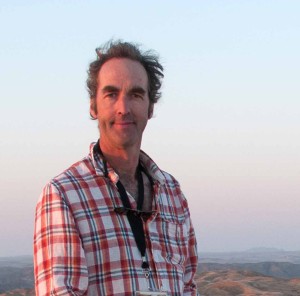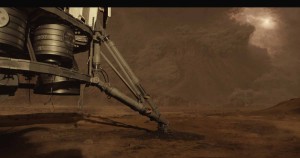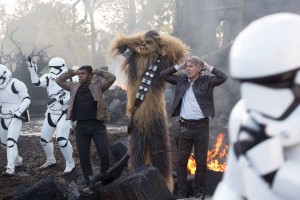The best compliment you can pay to visual effects artists is to not even notice their work. Of course, we all know that the Millennium Falcon isn’t real, but the vicious bear in The Revenant just might be. That’s the reason the Visual Effects Society makes the distinction between “outstanding visual effects” and “outstanding visual effects in a supporting role.” One is somewhat obvious, while the other blends seamlessly into the film. This year, Star Wars: The Force Awakens earned the former VES award, while The Revenant took home the later.
The Academy usually overlooks the “visual effects in a supporting role” category altogether, perhaps because it isn’t so obvious, but considering the momentum that The Revenant has going into the awards, it’s hard to rule it out.
In this digital age it’s easy to forget the visual effects category also includes practical special effects like creatures, models, miniatures and other in-camera effects. But in 1982, Tron was disqualified from receiving an Academy Award nomination for special effects, because the Academy felt at the time that using computers was unfair.
Today, a globalized visual effects industry evolves at the speed of Moore’s Law. It’s not uncommon for summer tentpole films to rely on the work of 1,000 artists hailing from a dozen different facilities all over the world, each with their own specialty. But it’s the VFX supervisors who oversee the entire process, and dole out the work, that get the accolades come Oscar night.
The contenders for this year’s Oscar for best visual effects are:

The visual effects team of Andrew Whitehurst, Paul Norris, Mark Ardington and Sara Bennett faced the challenge of creating a lead character, Alicia Vikander’s Ava in Ex Machina. Whitehurst explained that given the notorious difficulty of matching the tiny, subtle motions of a human being in CG, the VFX team at London-based Double Negative put in “a massive effort of developing new tools… building new ways of rigging the character to give us the flexibility that we needed.”
“The initial conversations for the first three months or so were presenting ideas for the design of Ava, making suggestions as to what we could do with costume, to get the most in camera, where it made sense to replace with CG and where it didn’t given restrictions of time and budget,” explained Whitehurst.
 While the number of discrete shots was not large by modern standards (Whitehurst recalled that his department dealt with perhaps 350 in all), the duration of these shots was often long, averaging around 200 frames and peaking at a 1,600 frame monster over a minute long.
While the number of discrete shots was not large by modern standards (Whitehurst recalled that his department dealt with perhaps 350 in all), the duration of these shots was often long, averaging around 200 frames and peaking at a 1,600 frame monster over a minute long.
The work was driven by a need to maintain the character’s clearly mechanical appearance. “We were always talking about her needing to feel organic up to a point, but also feeling very mechanical. You don’t want her to feel like some sort of Steampunk creation.”
“I cannot think of any other project that Double Negative’s done that has that level of complexity,” said Whitehurst.

The team of Andrew Jackson, Tom Wood, Dan Oliver and Andy Williams are nominated for their work on George Miller’s post-apocalyptic action film Mad Max: Fury Road, which seamlessly blended practical and visual effects. On the practical side, over 100 real vehicles were built in Australia and shipped to the Namibian dessert for the shoot.
In terms of VFX, Sydney-based visual effects house, Iloura, (formerly Method Studios), handled the vast majority of the film’s digital work. In total, the film has over 2,000 VFX shots out of 2,600.

“A lot of what we did was augmenting what was already exciting live-action elements,” explained Jackson. That included a lot of environment extensions, as well as “some pretty major CG sequences as well.”
Jackson explained that “My approach to visual effects is very much using live-action elements as much as possible. Even if it’s all CG, I always try to base it on some sort of element. So we shot the vehicles driving around for a base plate to work with. Occasionally, by the time you’re done, all of the elements in the shot have been replaced one by one, until there is nothing left of the original plate, but I still believe that the shots inherit something from the original plates that helps make them more believable. It may be only the camera move, but I feel that there is a benefit of basing a visual effects shot on some kind of a live-action plate.”
Jackson explained that one of the biggest challenges the VFX artists faced was the fact that there were about 600 shots where the vehicles are supposed to be on the move, but were actually filmed with stationary vehicles.
“We had to make them appear as if they’re moving,” he explained. “Sometimes it can be easy, when there isn’t much background, but there were some shots where the actors were standing on vehicles and climbing all over them, and we had to make them appear as if they were moving. When you a have a performance from an actor standing on a vehicle that’s not moving, to get that to appear as if they’re on a moving vehicle, without losing their performance was definitely one of the most challenging things in the film.”

Richard Stammers, Anders Langlands, Chris Lawrence and Steven Warner are nominated for their work on The Martian.
Stammers explained that one of the key challenges was the compressed schedule.
“Normally, on a Ridley Scott film we’d have 18 months, from prep to post,” said Stammers, who has previously worked with the director on Robin Hood, Prometheus and The Counselor. “But on this we had a year. What was probably the tricky thing for us was the postproduction schedule, which was 24 weeks.” That had originally been slated for 28 weeks, but a month was lopped off so the film would be able to kick off the Academy viewing season early.
With such a tight schedule, most of the work was handled between three post houses: Stammers’ own MPC, The Senate Visual Effects and Framestore. “MPC did all the Mars surface work. The Senate did everything on Earth,” he recounted, including the views from various NASA buildings and JPL sequences. Framestore, however, got to do both Mars and Earth, as they were each viewed from space (along with the in-space shots, too).
And as production deadlines drew closer, additional shops were also used, notably, “Atomic Arts, ILM London and Milk – a small company also here in London.”

Stammers explained that “with our greenscreen stage work, we always knew what our background was going to be. We had already built a lot of the digital environment based on what we saw on the location scout.”
Stammers said the color balancing was an interesting part of the whole process, seeing yellow and pink skies, and realizing “there’s no grey sky on Mars. But we wanted to embellish that further, with a more dramatic interpretation.” So not only were dust plumes visually added, but Stammers and his MPC crew “ended up writing our own algorithm for Mars.”
Stammers described it as “an expression-based algorithm written within Nuke.” It helped remove visual noise artifacts, and allowed them to not have to rotoscope actors for certain Martian background scenes, and made for easier removal of blue from shots — whether Earth-like blue skies, or studio-like bluescreens. Stammers noted that the new “Martian” algorithm they created is now being used as “a spill suppressor for bluescreen work.”

Guyett explained that there were over 1,000 artists working on 2,100 visual effects shots in the film, and the first step was to break them all down and distinguish between “real creatures and in-camera effects and what we would do in post.”
“It was a very formidable task breaking it down into the various components and dividing it up between a very large team of people, while collaborating with J.J. and making sure that we’re all heading in the right direction, along with every other department for that matter.”
 According to Guyett, the approach to effects was to try “to retain some of the charm of the process of the original movie, with real creatures and real locations, and then mash that up with this incredible new technology that we have in our arsenal, and hopefully by doing that, we’re grounding the work in reality.”
According to Guyett, the approach to effects was to try “to retain some of the charm of the process of the original movie, with real creatures and real locations, and then mash that up with this incredible new technology that we have in our arsenal, and hopefully by doing that, we’re grounding the work in reality.”
Tubach added while the old films gave them a wealth of reference material, there were also a lot of new ships and new characters that needed to be designed from scratch.
“Every single decision that we had to make had to be weighed against the question, ‘Does this feel like something that could exist 30 years on from the original trilogy?’” Tubach added. “We were very careful to be faithful to the original look of the films. That was really an overriding thing hanging over our heads.”
Scanlan and his creature effects team were tasked with creating 110 practical creatures for the film. In fact, in one of the most striking scenes in the film, Maz’s Castle, all of the creatures are real, except one – Maz herself. That scene called for a team of 130-140 puppeteers, performers and choreographers. Having real practical creatures allowed Abrams to direct all of the actual characters on set.
For Corbould, one particular challenge was Rey’s speeder. “We made one version and showed the footage to J.J. and he said, ‘That’s grand. It’s unique. It’s wonderful. Can you make it sway from side to side?’ So we did that and sent the footage back to him again and he said, ‘That’s lovely, but can you make it go up and down one or two feet?’ So every time he saw it he kept improving it.”

Rich McBride, Matthew Shumway, Jason Smith and Cameron Waldbauer are nominated for their photorealistic work on The Revenant.
To research grizzly bear behavior, McBride and his ILM keys looked at a healthy amount of reference footage from YouTube and a documentary about Yellowstone. Given the subtleties which he wanted to translate to his computer-generated grizzly, McBride also reviewed materials regarding how bears stalk their prey. “How they use their snout and mouth and eyes,” he discovered. “They don’t convey emotion, but there’s a lot of expression that’s happening. Getting into the details – the smells, the saliva – they attack the face quite a bit. In our case, mama bear is protecting her cubs. We pulled from all of these sources as an initial starting point.”
 To develop the particulars of the attack, McBride and the principal photography unit, including the stunt team, assembled the choreography of their scene, much of which is shot in long takes, in spring of 2014. “Chivo [cinematographer Emmanuel Lubezki] and Alejandro brought the camera in,” McBride remarked. “It was an amazing collaboration to set the stage for the visual effects team to have a performance from Leo. We had a good launching point for what our bear would look like. We wanted her to feel quite large, especially compared to Leo.”
To develop the particulars of the attack, McBride and the principal photography unit, including the stunt team, assembled the choreography of their scene, much of which is shot in long takes, in spring of 2014. “Chivo [cinematographer Emmanuel Lubezki] and Alejandro brought the camera in,” McBride remarked. “It was an amazing collaboration to set the stage for the visual effects team to have a performance from Leo. We had a good launching point for what our bear would look like. We wanted her to feel quite large, especially compared to Leo.”
By the end of December 2014, principal photography turned the bear attack plates over to ILM, allowing for them to begin roughing in their computer-generated bear.
Through the first nine months of 2015, ILM endeavored to block in, refine, and finesse final bear shots. “There was a lot of nuance going into the motion and there’s the look of the fur,” McBride commented. “A lot of detailing that took quite a bit of time. I worked with a brilliant team that could be technical but had amazing artistic qualities.”
Vote in Below the Line‘s Unofficial Awards Poll
[poll id=”82″]





